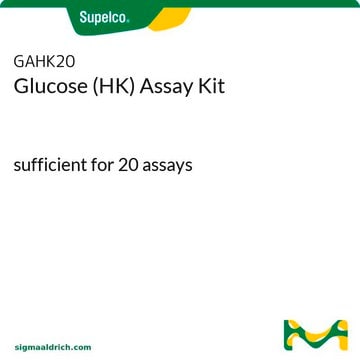MAK076
Ethanol Assay Kit
sufficient for 100 colorimetric or fluorometric tests
Se connecterpour consulter vos tarifs contractuels et ceux de votre entreprise/organisme
About This Item
Code UNSPSC :
12161503
Nomenclature NACRES :
NA.84
Produits recommandés
Utilisation
sufficient for 100 colorimetric or fluorometric tests
Application(s)
cosmetics
food and beverages
Méthode de détection
colorimetric
fluorometric
Température de stockage
−20°C
Description générale
The new Ethanol Assay Kit, MAK481, is now available! Ethanol is a psychoactive component of many commonly consumed drinks where it acts as a central nervous system depressant. After ingestion, ethanol is absorbed into the bloodstream via the stomach and small intestine. Ethanol is largely metabolized by the liver but is also secreted in urine or through respiration. The monitoring of ethanol levels is also important in fermentation processes. The ethanol assay kit provides a simple and reliable method for the quantification of ethanol.
This kit is highly sensitive to the presence of short-chain alcohols (ethanol, methanol, and propanol). Storage or use of this kit in the vicinity of alcohol vapors can result in the uptake of the alcohols by kit components, resulting in very high backgrounds.
This kit is highly sensitive to the presence of short-chain alcohols (ethanol, methanol, and propanol). Storage or use of this kit in the vicinity of alcohol vapors can result in the uptake of the alcohols by kit components, resulting in very high backgrounds.
Application
Ethanol Assay Kit has been used :
- to measure the levels of ethanol in yeast cell culture supernatant and to study the link between metabolism and chromatin structure
- to determine the ethanol levels in compound beverages and foods
- to measure ethanol content in vinegar
Adéquation
Suitable for determining the concentration of ethanol in serum, plasma, and other body fluids as well as in beverages and growth media.
Principe
Ethanol concentration is determined by a coupled enzyme reaction, which results in a colorimetric (570 nm)/fluorometric (λex = 535/λex = 587 nm) product, proportional to the ethanol present. The Ethanol Assay Kit provides a simple and reliable method for the quantification of ethanol in serum, plasma, and other body fluids as well as in beverages and growth media.
Remplacé(e)(s) par
Réf. du produit
Description
Tarif
Mention d'avertissement
Danger
Mentions de danger
Conseils de prudence
Classification des risques
Aquatic Chronic 3 - Eye Irrit. 2 - Flam. Liq. 2
Code de la classe de stockage
3 - Flammable liquids
Point d'éclair (°F)
57.2 °F - closed cup
Point d'éclair (°C)
14.0 °C - closed cup
Certificats d'analyse (COA)
Recherchez un Certificats d'analyse (COA) en saisissant le numéro de lot du produit. Les numéros de lot figurent sur l'étiquette du produit après les mots "Lot" ou "Batch".
Déjà en possession de ce produit ?
Retrouvez la documentation relative aux produits que vous avez récemment achetés dans la Bibliothèque de documents.
Les clients ont également consulté
Detecting ethanol and acetaldehyde by simple and ultrasensitive fluorimetric methods in compound foods.
Zachut M, et al.
Food Chemistry, 201, 270-274 (2016)
Metabolite profiling and volatiles of pineapple wine and vinegar obtained from pineapple waste.
Roda A, et al.
Food Chemistry, 229, 734-742 (2017)
Michael S Patton et al.
Neuropsychopharmacology : official publication of the American College of Neuropsychopharmacology, 46(2), 351-359 (2020-07-15)
Compulsive alcohol consumption is a core, treatment-resistant feature of alcohol use disorder. The dorsomedial and dorsolateral striatum support goal-directed and habitual action strategies, respectively. How ethanol targets dorsolateral striatum to drive compulsive consumption is poorly understood. Parvalbumin-expressing striatal fast-spiking interneurons
Shiyu Xu et al.
eNeuro, 5(3) (2018-06-19)
Ethanol has robust effects on presynaptic activity in many neurons, however, it is not yet clear how this drug acts within this compartment to change neural activity, nor the significance of this change on behavior and physiology in vivo. One
Gemma Aragonès et al.
International journal of obesity (2005), 44(4), 875-885 (2019-08-08)
Non-alcoholic fatty liver disease (NAFLD) causes a wide spectrum of liver damage, from simple steatosis (SS) to cirrhosis. SS and non-alcoholic steatohepatitis (NASH) cannot be distinguished by clinical or laboratory features. Dysregulation of the gut microbiota is involved in NASH
Notre équipe de scientifiques dispose d'une expérience dans tous les secteurs de la recherche, notamment en sciences de la vie, science des matériaux, synthèse chimique, chromatographie, analyse et dans de nombreux autres domaines..
Contacter notre Service technique








